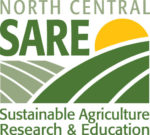Acknowledge SARE and USDA-NIFA as your Funding Sources
The following language and logos have been developed to include on products and publications associated with SARE, and were updated in 2015.
Acknowledging SARE as a funding source is required for all program materials developed with SARE funds, including publications like bulletins, guides, fact sheets, academic journal articles, project posters, PowerPoint presentations, SARE-supported event materials like webinars, workshop handouts, websites, video credits, and other deliverables.
The awardee is responsible for acknowledging SARE and USDA-NIFA support verbally during news media interviews that discuss work supported by SARE.
Acknowledgement Language
This material is based upon work that is supported by the National Institute of Food and Agriculture, U.S. Department of Agriculture, under agreement number XXXX-XXXXX-XXXXX through the North Central Region SARE program under project number XNC21-XXX. USDA is an equal opportunity employer and service provider. Any opinions, findings, conclusions, or recommendations expressed in this publication are those of the author(s) and do not necessarily reflect the view of the U.S. Department of Agriculture.
Note: If you have questions or need help determining the numbers to use, please contact the NCR-SARE office for assistance.
Logo Information
Whenever practical, NCR-SARE and USDA-NIFA expect that grantees will use NCR-SARE's and USDA-NIFA’s official identifier in publications, posters, websites and presentations resulting from their award.
Before downloading logos, please read the logo usage guidelines.
NCR-SARE Logo Files
To download an NCR-SARE logo, click on the file name. Download will automatically begin in your web browser.
NCR-SARE Color Logo Files (CMYK)
| File | Format | Use |
| Note: These files must be used against white or light colored backgrounds. Image includes border space that must be maintained. | ||
|
| GIF | Preferred for Web, PowerPoint, other documents that will be printed on laser or inkjet printers |
|
| JPG | Web, PowerPoint, other documents that will be printed on laser or inkjet printers |
|
| TIF | Graphic design, high-quality printing on presses, large logo needed (e.g. for banner) |
|
| EPS | Graphic design, high-quality printing on presses |
NCR-SARE Black and White Logos
| File | Format | Use |
| Note: These files must be used against white or light colored backgrounds. Image includes border space that must be maintained. | ||
|
| GIF | Preferred for Web, PowerPoint, other documents that will be printed on laser or inkjet printers |
|
| JPG | Web, PowerPoint, other documents that will be printed on laser or inkjet printers |
|
| TIF | Graphic design, high-quality printing on presses, large logo needed (e.g. for banner) |
|
| EPS | Graphic design, high-quality printing on presses |
NCR-SARE Transparent Logo Files
| File | Format | Use |
| Note: Image includes border space that must be maintained. | ||
|
| GIF | Use for web, PowerPoint where dark backgrounds are required |
|
| TIF | Graphic design, high-quality printing on presses where dark backgrounds are required |
USDA-NIFA Logo Files
USDA-NIFA provides identifiers in several file formats, color modes, and resolutions for specific use in various software applications:
For use in Powerpoint
For use in Word, Publisher, InDesign, etc.
For use on Web
Click here for more information about using the USDA-NIFA logo.
For Staff (Internal Publications)
For SARE-Branded Products Produced Internally
This product was developed by the Sustainable Agriculture Research and Education (SARE) program with funding from the National Institute of Food and Agriculture, U.S. Department of Agriculture (NIFA-USDA). Any opinions, findings, conclusions or recommendations expressed within do not necessarily reflect the view of the U.S. Department of Agriculture. U.S. Department of Agriculture is an equal opportunity provider and employer.
For Book Title Pages
This product was developed by the Sustainable Agriculture Research and Education (SARE) program with funding from the National Institute of Food and Agriculture, U.S. Department of Agriculture (NIFA-USDA). Any opinions, findings, conclusions or recommendations expressed within do not necessarily reflect the view of the U.S. Department of Agriculture. U.S. Department of Agriculture is an equal opportunity provider and employer.
Every effort has been made to make this product as accurate as possible. This text is only a guide, however, and should be used in conjunction with other information sources on the subject. The editors and publisher disclaim any liability, loss or risk, personal or otherwise, that is incurred as a consequence, directly or indirectly, of the use and application of any of the contents of this product. Mention, visual representation or inferred reference of a product, service, manufacturer or organization in this information product does not imply endorsement by USDA, NIFA or the SARE program. Exclusion does not imply a negative evaluation.U.S. Department of Agriculture is an equal opportunity provider and employer.


